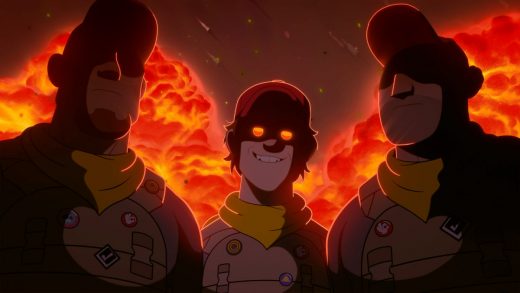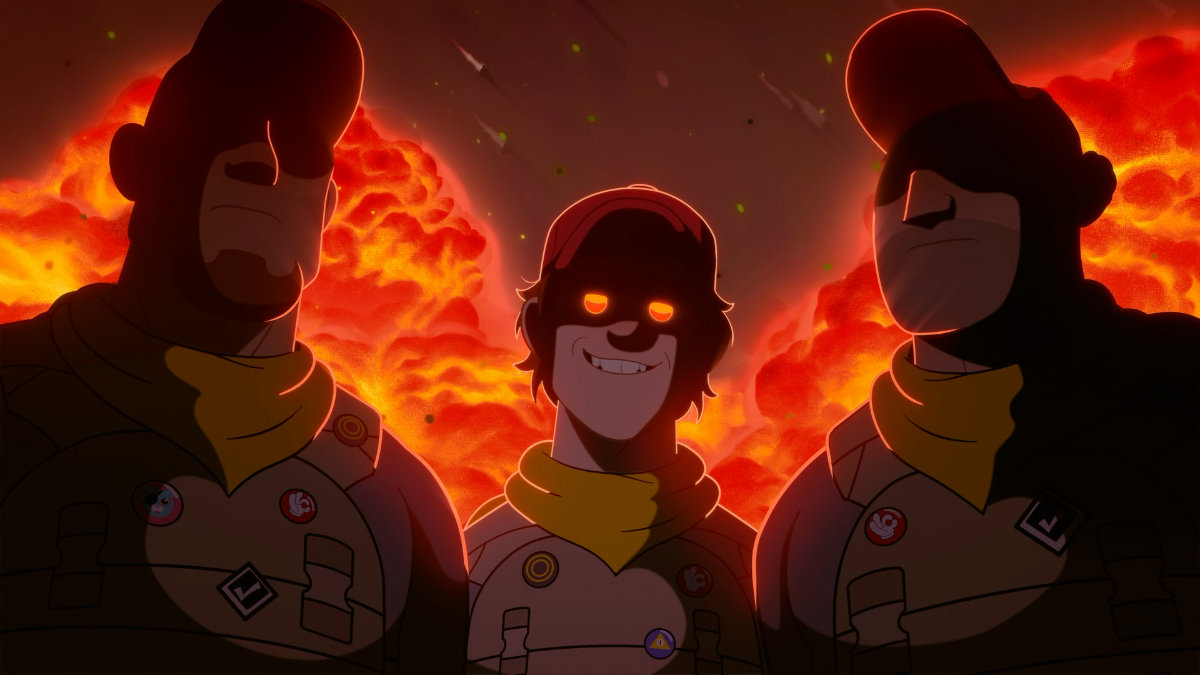
Hey Men! is an indie Canadian-made 2D animated short about the rise of fascism in contemporary society. Framed as a rock opera, this 5-minute film leverages music and a familiar commercial aesthetic — think Disney’s television animation meets Kubrick’s Full Metal Jacket — to critique populist ideology from within the medium itself.
Delving into the conditions that draw people to hate movements, the film examines what’s at stake if society continues to ignore the suffering of men. Hey, Men! will premiere as part of the Canadian Shorts Panorama at the 2024 Ottawa International Animation Festival.
The film was written, produced, and directed by Tabitha Fisher with animation overseen by co-director Spencer Moreland — both industry vets who have recently turned their focus to developing artist-driven, original IP. We caught up with Tabitha and Spencer to learn about the making of this epic indie short.
To begin, can you each introduce yourself, and share a bit about your animation career to date?
Tabitha: My background is in 2D Layout and Painting, and I have supervised at studios throughout Toronto, like Nelvana, Guru, and DHX, since I graduated from Max the Mutt Animation School’s 3-year diploma program in 2007. I kind of fell into those roles as someone who graduated into a recession, but I have other interests, such as teaching, writing, and directing.
In 2011 I made a short with the NFB’s Hothouse program, which, as a young person, was the first time I felt that my creative ideas were being taken seriously. That experience launched me on a quest to recreate this feeling for myself and others, which led me to pursue an MFA at OCADU so I could make mentorship and creative exploration my full-time job. I’m currently a permanent Faculty member in the BA Animation Program at Sheridan College, where I teach students how to find their artistic voice through background design and animated short filmmaking.
Spencer: I’m an animator and filmmaker based in Ottawa. I graduated from the Algonquin College animation program in 2013 and began working as an animator at various local studios. Most of that time was spent at Jam Filled as a senior animator and animation supervisor, working on shows like The Loud House. This is where I learned to use Toon Boom Harmony from some of the people who know it best; artists who were instrumental in developing the way we use the software today. They were great mentors who also taught me how to lead a team and support people so they could do their best work.
In 2020, I left the studio to pursue freelance jobs as an animator and storyboard artist, while producing my own independent shorts. In the fall of 2022, I was looking for a new project, and a friend from Jam Filled introduced me to Tab, who wanted an animation director for Hey Men! We orbit in the same social circles and knew of each other in passing but had never formally met until we started talking about the film. Although I was initially brought on to focus strictly on the movement style, from the beginning, Tab had me collaborate with her on other aspects of the film. As we addressed final revisions to the animatic, and talked through choices for character designs, and even voice acting, we quickly realized how well we work together; which is how I came to be credited as co-director.
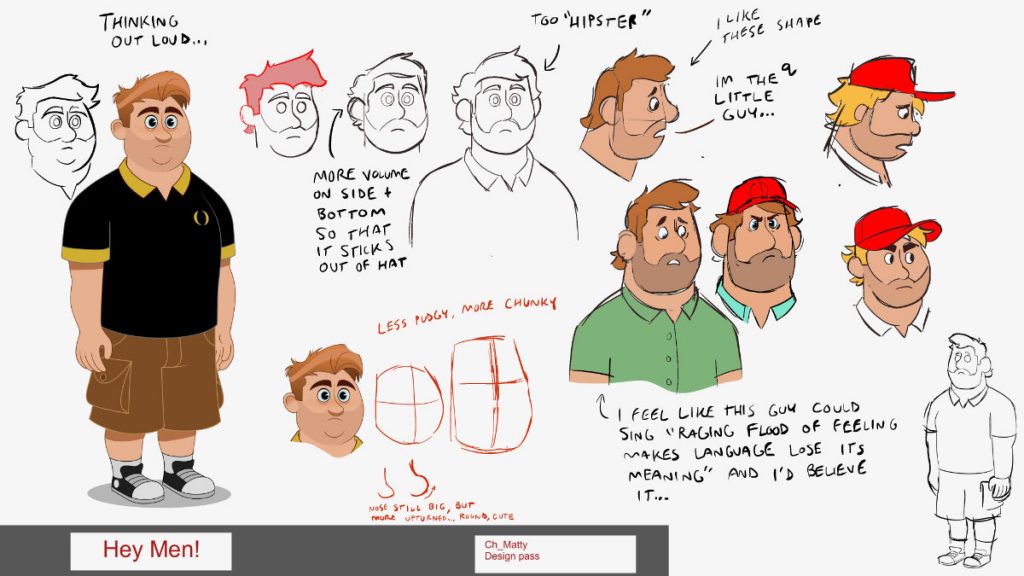
Can you provide some background about the project’s financing and development? Is it an independent film, or associated with a studio?
Tabitha: Hey Men! is an auteur-driven, independent production, and the financing was cobbled together by me, as a first-time producer who was learning as I went. Since the film is so of-the-moment, I did not want to wait around for someone to give me permission to make it and risk having the project languish in creative purgatory. I also wanted to prove that I could execute such a complex project while building a remote high-end pipeline that worked for production.
This is not the kind of project you would propose to a service studio, and it would not be appropriate to raise money through crowdfunding; the idea of making merch for a film about fascism, like buttons and hats, is totally cringe! So, I turned to grants, partnerships, and in-kind services from The Canada Arts Council, The NFB FAP program, Sheridan College, Toonboom, ASIFA-Hollywood’s Animation Educator’s Forum, and several private donors.
Of course, as an indie producer, I pitched in my rainy-day fund and did not pay myself. Spencer and I also incorporated a production company to allow us to capture tax credits. Crewing this project with mostly seniors meant the film was not cheap, but it was important to me that my team was compensated fairly. I’m proud to say that everyone on this production was paid their studio rate or better.
As for the film’s development, I knew that the project was risky, so I designed the workflow with a set of off-ramps. The first chunk of funding went to the animatic and initial voice record that I used to demonstrate (mostly to myself) that I could capture the correct tone for such a film, given the sensitive nature of the subject matter. Once pre-production came together, better than I could have imagined, there was a distinct “uh-oh” moment where I realized that it was now my responsibility to steward this important project through to the end. Spencer was instrumental in helping me find the right senior-level people to round out the animation team, and the two of us quickly got on the same page creatively so that he was able to understand my vision for the film.
I was building out the tracks as the train was running at full speed — while also managing my full-time job as a professor with 150 students. I also designed and painted all 55 backgrounds in 4K by myself because I like pain. Basically, I did not leave my work desk for about two years.
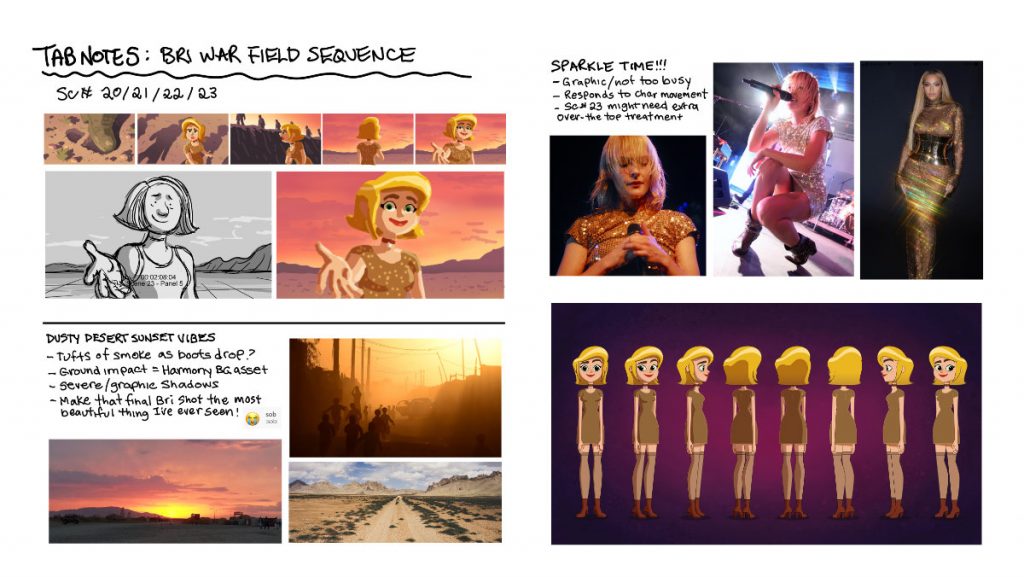
Tabitha, how did you know that Spencer was the right fit to come on as a co-director?
Tabitha: The first time Spencer saw the film was in the late stage of animatic development, as I was looking for someone to lead the animation team. What struck me was that he immediately understood the project at a deep level, as he was already well versed with the issues being explored.
This was critical in his original role as animation director, but, as we continued working together and the scale and scope of the project grew, he naturally fell into this elevated position. It is a relationship that is built on trust. I did not need to explain to him why I was making a feminist film about the hardships of men. This is a project that walks a delicate emotional line, and he got what I was looking to do, even in that early stage, which is exceedingly rare.
How did you go about building a team for Hey Men! and were there unique considerations involved?
Spencer: When I first saw the animatic for Hey Men! I could sense that Tab was approaching these issues with a clarity of insight that felt refreshing. These are difficult things to talk about and it often seems as though two sides are just constantly screaming past each other — attempting to win arguments with logic, while ignoring the emotional reasons why someone might look for easy answers presented by the alt-right and other fascist-leaning ideologies. So, when it came time to build the team, we were looking for people with an emotional sensitivity that would allow them to take a sophisticated level of direction, in order to maintain that clarity through production of the film.
Tab took a lot of cues from live action filmmakers — specifically the philosophies of Sarah Polley and Guillermo Del Toro, who stress the importance of an iterative workflow. We were able to assemble a team of amazingly talented animators.
At their studio jobs, these people are not used to getting retakes, but we knew on this production that “great animation” would just be a starting point, from which we could iterate on these scenes through multiple revision passes to hone in on the emotional truth in each performance.
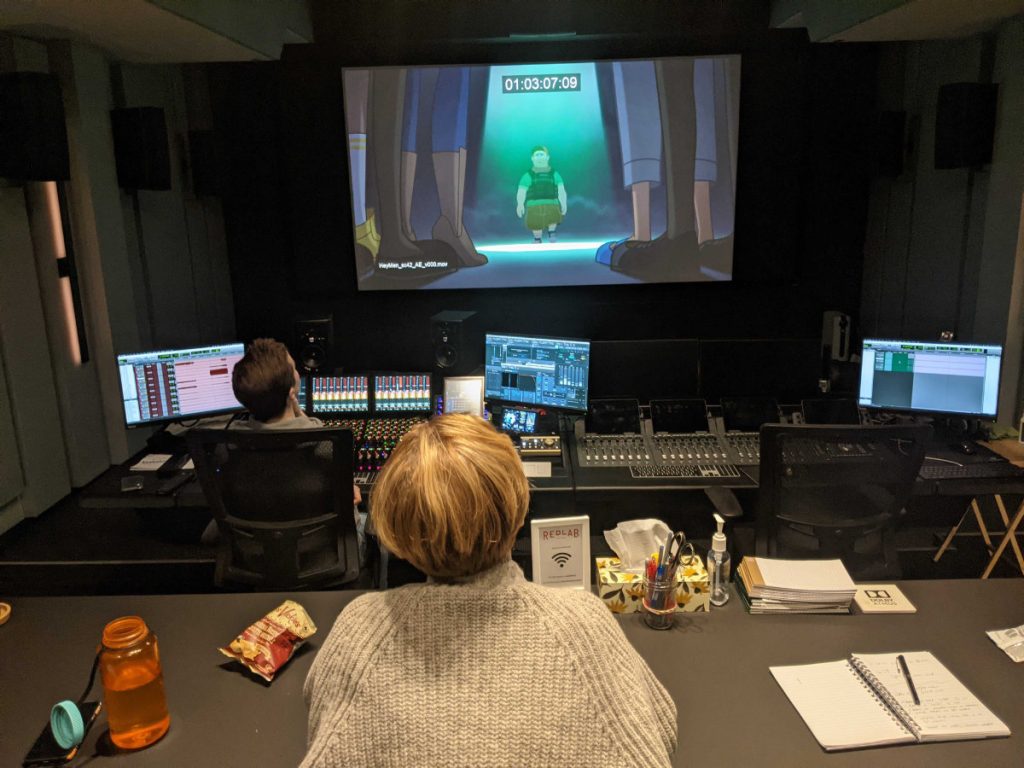
Hey Men! examines how authoritarian movements take advantage of people’s loneliness to attract followers. What inspired you to tackle this highly relevant issue?
Tabitha: The film was inspired by a mixture of my own observations from a lifetime of being a woman in the world, as well as people I have known over the years. In some cases, I had a close-up view of the contradictory nature of the human experience: specifically, how someone can be filled with contempt for the world while at the same time crave affection from within it, which underscores the ways in which hate is simply the affliction of a wounded soul. Men are taught that stoicism is the antidote to their suffering, and it is within this context that contemporary fascism has taken root.
I had observed what was happening in the United States at the Capitol as well as the trucker convoy in Ottawa and was struck by the gleeful tone of the participants. It was like they were play-acting a revolution, which gave them a sense of belonging and purpose. The trick with extremist movements is they offer community to those who have become distanced from friends and family, by whispering in their ear, “nobody sees your pain but us.”
These are old techniques of manipulation that have been utilized across history, and I felt as though my unique experience gave me the tools to cut through the divisive rhetoric to expose the emotional roots of the movement. To bear witness to another’s suffering — as the object of their hate — is one of the most powerful deradicalization tools we have; and that’s what I strive to do with Hey Men!
There’s a musical element to Hey Men! What inspired this aspect of the film?
Tabitha: Hey Men! was always going to be framed around a song, as I find my brain works naturally with music. There was a lot of complex information that I needed to convey in less than five minutes and, as Disney knows well, a Broadway-style number is capable of dense emotional storytelling in a short period of time. I was looking to capture the overwhelming, chaotic, and cartoonish experience of living in the world today. When I think of how it feels to be a person at this time in history, my mind goes immediately to… a rock opera.
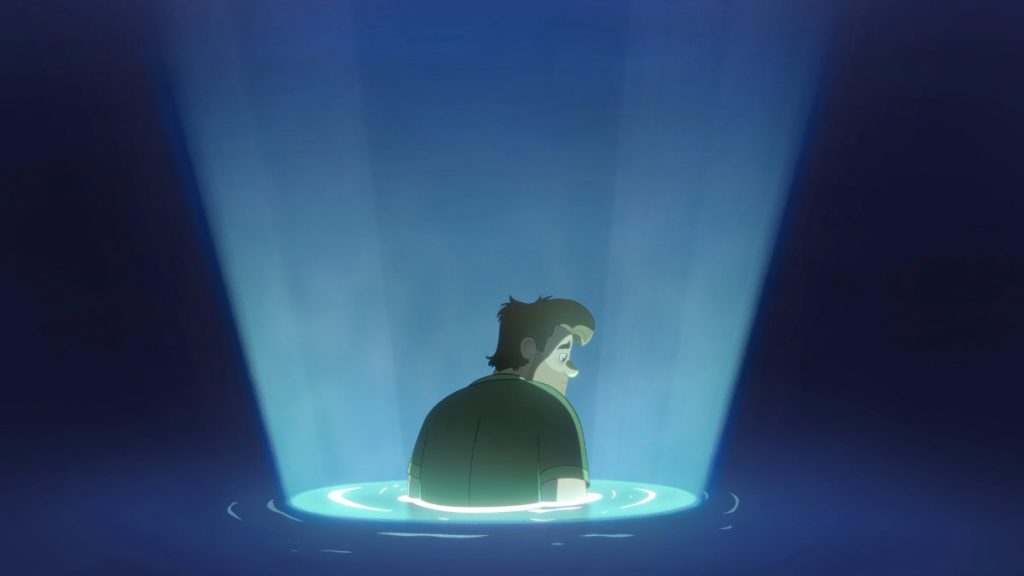
Tabitha, as the writer of the film, how did you approach crafting the script in such an informed way? Did you base it on research?
Tabitha: Much of the early development included research about the pathways to extremism and techniques for deradicalization. I read case studies about men who had been drawn into hate movements as well as the methods that help people to exit them.
Pro-democratic organizations in both the USA and Canada were extremely helpful, as were research labs focused on men’s mental health, so I was able to gather both hard facts and real-world stories. I came into the project with an informed perspective already, but I wanted to make sure I could back up all my creative decisions with evidence.
Research was critical during the writing and boarding stages, as well as during production. There were countless times on Hey Men! where I had to trust my gut, and I was able to make decisions with a level of confidence that came from thoroughly understanding the subject matter.
Everything from the acting performance and down to the buttons on a bulletproof vest were heavily scrutinized to ensure the film was grounded in the real world. I pulled in both contemporary and historic ideas about violence and gender. My goal was to guide the audience to feel the full spectrum of their emotions, and to do so from an informed place.
Hey Men! is 2D rigged animation with a commercial studio appearance. How did you land on this look?
Tabitha: It was important that the film was presented in a way that did not immediately deter the audience. In the early stages of development, I was leaning towards a look that felt more artsty, like my personal drawings, but it felt wrong for the project. I needed the style to feel familiar and accessible which, ironically, is a method that is well understood by the alt-right. Commercial-style animation is a populist medium, so I decided to use it as an opportunity to critique populism from within the medium itself. That kind of meta-commentary is the stuff I live for.
Spencer: Pretty early in our discussions about technique and workflow, we recognized the potential to tap into the amazing pool of local talent. Ontario is a powerhouse when it comes to making some of the best 2D rigged animation out there, and we realized that we could bring some heavy hitters to the project by leaning into our network.
I made a list of some of the most talented animators I know and started reaching out. To my delight, a lot of them were enthusiastically saying “yes!” and it reminded me that artists are hungry for opportunities to continue growing. They always want to push the bar higher. There’s a generation of animators who have done incredible work in their careers, but they’re hitting the ceiling of what is possible under the demands of a TV-schedule-based production in a typical studio environment.
On this project, we were able to create room for them to stretch those abilities with a feature-level quota. That extra time and care allowed us to dig deeper into character motivation to convey those emotions with a nuance that has always been possible with 2D rigged animation, though we’re rarely given the opportunity to explore it.
Because this narrative is so emotionally dense, every moment counts. The audience must know what the character is thinking and feeling on every syllable. For example, we had a rule that, for shots where a character was hiding behind an emotional façade, they would have a snappier, more exaggerated performance style.
In contrast, when the character was being more vulnerable, the movement became more naturalistic. On top of that were layers of technical complexity — tricky angles and perspective changes, slow cross-dissolves where the character animation and lip sync had to hook-up perfectly, and, of course, a custom shadow treatment on every scene.
It was challenging, but this is also where the 2D rigged technique allowed us to work through them while maintaining that iterative workflow. Tab and I could call notes on posing and animation to finesse the performance without re-doing entire sections of the scene. With hand-drawn 2D, the same quality would not have been possible on this budget. There was so little waste. Using the rigged technique gave us the ability to be precise and controlled, like in 3D, but with the appeal of 2D, and it felt like we cracked the code on a workflow for feature-quality 2D rigged animation.
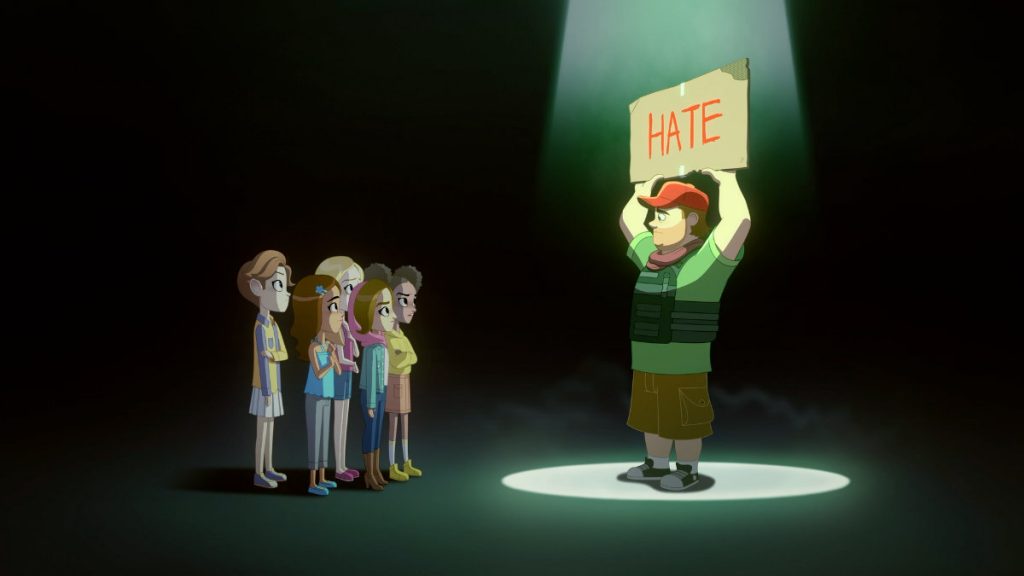
How does animation and song help to portray radicalization in an accessible way?
Tabitha: The format of an animated musical is instantly disarming because it grounds the film in an aesthetic that you typically associate with Disney. That becomes the entry point to discussing such a sensitive and emotionally polarizing topic.
When I pictured the audience, I imagined my harshest critics, prepared to dismiss Hey Men! as some kind of “woke lecture about feminism” and I wanted to hint it was going in that direction, then rip those expectations away. There are things in the film that I don’t think I’ve ever seen depicted in animation, and this medium is so great at taking the sharp edge off the brutal aspects of the human experience, so it can be digested by an audience. It’s intense.
Hey Men! takes the vibe of the last ten minutes of Full Metal Jacket and forces you to sit with it until you feel something.
Spencer: Then there’s the song. So catchy! Even now, I find myself randomly humming parts throughout the day. The melody and the instrumentation really guide the audience through the emotional beats. The arrangement is really creative and repeat listens reveal a ton of beautiful stuff going on with the guitars and piano. The drums, which were actually added later, give the song an added level of urgency. Paired with the animation, the experience is powerful.
The team behind Hey Men! is made up of all-Canadian talent. Was a completely Canadian team your priority from the start?
Tabitha: There has been a lot of talk lately about the future of our industry, and how Canadian animation studios need to diversify beyond preschool service work, so we are less vulnerable to economic shock. That starts by empowering our senior artists to innovate, both in terms of the technique and the kinds of stories we tell. Thinking big picture, remember that Canada was built on a legacy of resource extraction; I believe this contributes to a mindset where we view ourselves as lacking agency over our direction. We just sit around, waiting to fulfill a need from elsewhere, rather than create our own opportunities.
Spencer: Tab and I wanted the film to showcase what local animation artists are capable of when given the resources to do our best creative work. I don’t like the idea that ambitious artists outgrow their small pond and feel the need to move to the USA or Europe to find that next big challenge, and the only way to push against that narrative is to create opportunities to continue developing our artistry here at home. We view Hey Men! as a step in that direction.

For the few who’ve seen the film so far, what has the reception been like? And when the film reaches a broader audience, what message do you hope viewers take away from it?
Tabitha: Few people have seen the film so far, aside from work-in-progress screenings of the animatic and rough assembly edit to ensure the message came through. It’s a provocative film that operates within the grey zone so, naturally, you’re going to get some strong reactions. I am asking essential questions about what it means to be a good person, and that’s emotionally unsettling stuff.
The majority get the film and appreciate the fresh perspective. Some people are offended, but it’s not who you might think. The most negative reactions come from those who feel as though their sense of goodness is being challenged. It’s in the same vein as that garden party scene from Jordan Peele’s Get Out, where the hosts really want you to know that they voted for Obama. These people don’t want to be lectured. But, the vast majority of people get what I’m doing with the film, and can see how I handled the subject with care. Some will walk into the film ready to hate it, and I aim to defy their expectations by holding up a mirror to their grief in ways they have not yet experienced.
As challenging as it may be, the rise of the alt-right is an issue best addressed with empathy, and people misunderstand empathy to mean we agree with someone, or we have had a shared experience with another person. However, to be empathetic is to simply listen. We do this to show an individual that we see them as human. This is not an intellectual conversation, it’s an emotional one. If we can listen, I think we have a chance at continuing to bend the arc of history towards a more equitable world.
There’s a lot of despair out there about how things are going. But there are many possible futures. We interact with the world in ways that nudge the needle one way or the other, and we can always change that direction, for better or for worse. I don’t have any delusions that this film alone will change things, but, if other people make works that initiate a similar conversation, we can begin to flip the script.
Where can people see Hey Men! and what is the plan for its broader release?
Tabitha: First, the film goes to the Ottawa International Animation Festival ‘24 this September. The plan is to have a full festival run throughout North America and Europe, then it will eventually make its way online. There is an educational component that I’m looking to develop with Hey Men! where I use it with young people as a tool to discuss the threat of political radicalization in society.
Spencer and I will continue working together through our new production company, Most Fun Studio, and are currently building up our slate. It has been an intense two years, but I’m so glad that, as an artist, I was able to produce something that I truly believe in. Making Hey Men! was a complete joy.
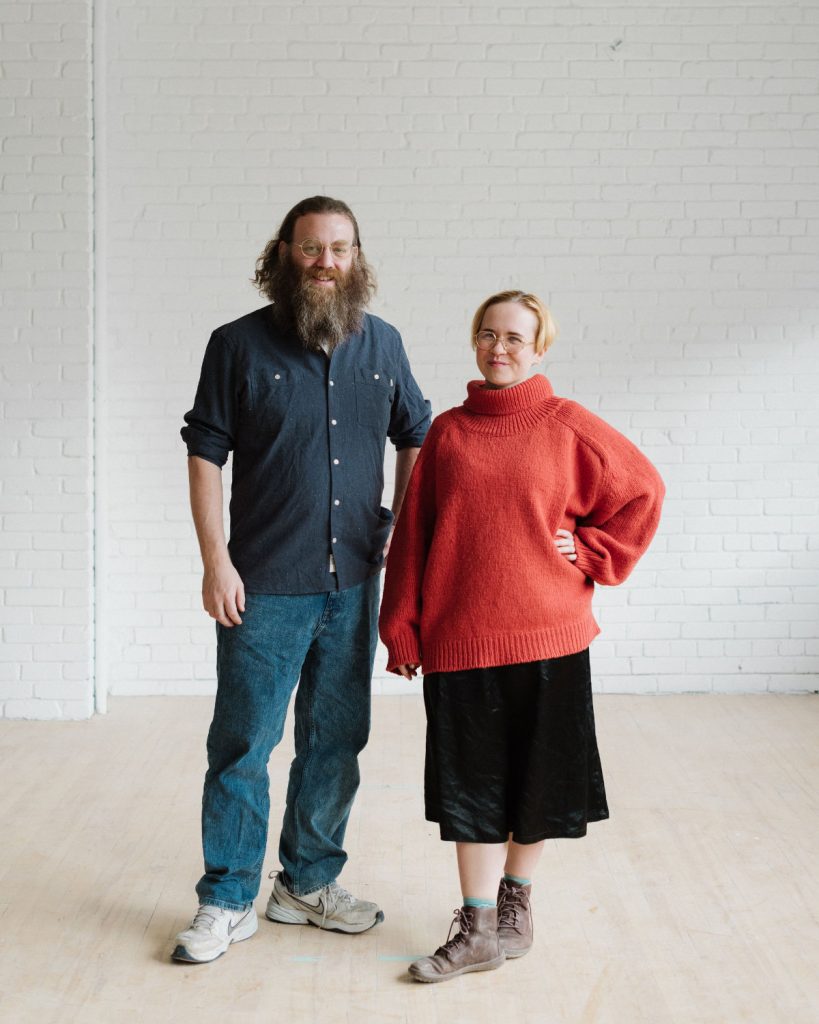
- Interested in learning more about Hey Men! and the team at Most Fun Studio? Be sure to follow Tabitha Fisher and Spencer Moreland on Instagram and visit the studio’s website.
- If you will be in Ottawa for OIAF, you can find screenings for the film on Thursday, September 26 at 5PM and Friday, September 27.
- Are you ready to get started on your independent production? Artists can download a free 21-day trial of Toon Boom Harmony.


